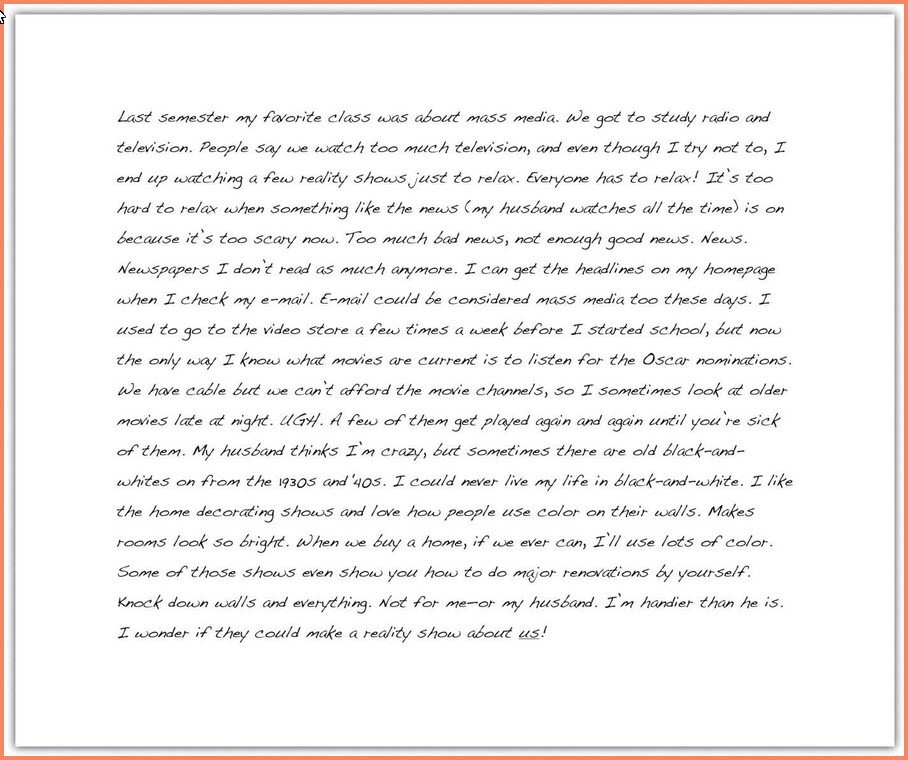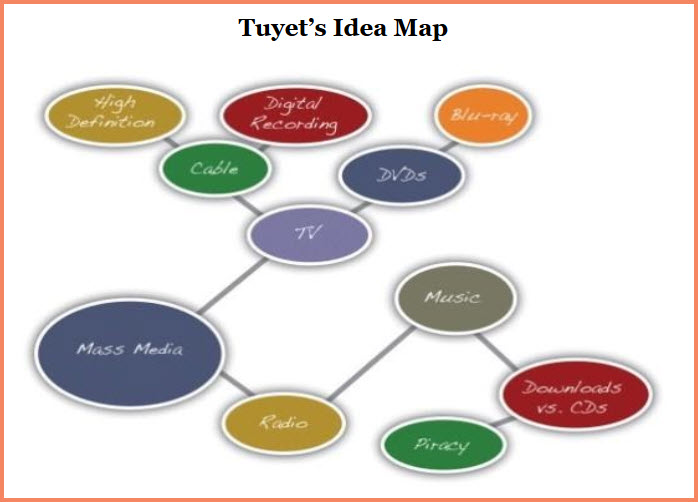14 The Writing Process: Prewriting and Drafting
Learning Objectives
- Conquer the blank page
- Use prewriting strategies to choose a topic and narrow the focus.
Prewriting
Prewriting is the stage of the writing process during which you transfer your abstract thoughts into more concrete ideas in ink on paper (or in type on a computer screen). Although prewriting techniques can be helpful in all stages of the writing process, the following strategies are best used when initially deciding on a topic:
- Using experience and observations
- Reading
- Freewriting
At this stage in the writing process, it is OK if you choose a general topic. Later you will learn more prewriting strategies that will narrow the focus of the topic.
Choosing a Topic
In addition to understanding that writing is a process, writers also understand that choosing a good general topic for an assignment is an essential step. Sometimes your instructor will give you an idea to begin an assignment, and other times your instructor will ask you to come up with a topic on your own. A good topic not only covers what an assignment will be about but also fits the assignment’s purpose and its audience.
In this chapter, you will follow a writer named Tuyet as she prepares a piece of writing. You will also be planning one of your own. The first important step is for you to tell yourself why you are writing (to inform, to explain, or some other purpose) and for whom you are writing. Write your purpose and your audience on your own sheet of paper, and keep the paper close by as you read and complete exercises in this chapter.
My purpose:
My audience:
Using Experience and Observations
When selecting a topic, you may also want to consider something that interests you or something based on your own life and personal experiences. Even everyday observations can lead to interesting topics. After writers think about their experiences and observations, they often take notes on paper to better develop their thoughts. These notes help writers discover what they have to say about their topic.
Tip
Have you seen an attention-grabbing story on your local news channel? Many current issues appear on television, in magazines, and on the Internet. These can all provide inspiration for your writing.
The Importance of Reading as Related to Writing
Reading plays a vital role in all the stages of the writing process, but it first figures in the development of ideas and topics. Different kinds of documents can help you choose a topic and also develop that topic. For example, a magazine advertising the latest research on the threat of global warming may catch your eye in the supermarket. This cover may interest you, and you may consider global warming as a topic. Or maybe a novel’s courtroom drama sparks your curiosity of a particular lawsuit or legal controversy.
After you choose a topic, critical reading is essential to the development of a topic. While reading almost any document, you evaluate the author’s point of view by thinking about his main idea and his support. When you judge the author’s argument, you discover more about not only the author’s opinion but also your own. If this step already seems daunting, remember that even the best writers need to use prewriting strategies to generate ideas.
Tip
The steps in the writing process may seem time consuming at first, but following these steps will save you time in the future. The more you plan in the beginning by reading and using prewriting strategies, the less time you may spend writing and editing later because your ideas will develop more swiftly.
Prewriting strategies depend on your critical reading skills. Reading prewriting exercises (and outlines and drafts later in the writing process) will further develop your topic and ideas. As you continue to follow the writing process, you will see how Tuyet uses critical reading skills to assess her own prewriting exercises.
Freewriting
Freewriting is an exercise in which you write freely about any topic for a set amount of time (usually three to five minutes). During the time limit, you may jot down any thoughts that come to your mind. Try not to worry about grammar, spelling, or punctuation. Instead, write as quickly as you can without stopping. If you get stuck, just copy the same word or phrase over and over until you come up with a new thought.
Writing often comes easier when you have a personal connection with the topic you have chosen. Remember, to generate ideas in your freewriting, you may also think about readings that you have enjoyed or that have challenged your thinking. Doing this may lead your thoughts in interesting directions.
Quickly recording your thoughts on paper will help you discover what you have to say about a topic. When writing quickly, try not to doubt or question your ideas. Allow yourself to write freely and unselfconsciously. Once you start writing with few limitations, you may find you have more to say than you first realized. Your flow of thoughts can lead you to discover even more ideas about the topic. Freewriting may even lead you to discover another topic that excites you even more.
Look at Tuyet’s example. The instructor allowed the members of the class to choose their own topics, and Tuyet thought about her experiences as a communications major. She used this freewriting exercise to help her generate more concrete ideas from her own experience.

Tip
Some prewriting strategies can be used together. For example, you could use experience and observations to come up with a topic related to your course studies. Then you could use freewriting to describe your topic in more detail and figure out what you have to say about it.
Exercise 1
Free write about one event you have recently experienced. With this event in mind, write without stopping for five minutes. After you finish, read over what you wrote. Does anything stand out to you as a good general topic to write about?
More Prewriting Techniques
The prewriting techniques of freewriting and asking questions helped Tuyet think more about her topic, but the following prewriting strategies can help her (and you) narrow the focus of the topic:
- Narrowing the focus
- Brainstorming
- Idea mapping
Narrowing the Focus
Narrowing the focus means breaking up the topic into subtopics, or more specific points. Generating lots of subtopics will help you eventually select the ones that fit the assignment and appeal to you and your audience.
After rereading her syllabus, Tuyet realized her general topic, mass media, is too broad for her class’s short paper requirement. Three pages are not enough to cover all the concerns in mass media today. Tuyet also realized that although her readers are other communications majors who are interested in the topic, they may want to read a paper about a particular issue in mass media.
Brainstorming
Brainstorming is similar to list making. You can make a list on your own or in a group with your classmates. Start with a blank sheet of paper (or a blank computer document) and write your general topic across the top. Underneath your topic, make a list of more specific ideas. Think of your general topic as a broad category and the list items as things that fit in that category. Often you will find that one item can lead to the next, creating a flow of ideas that can help you narrow your focus to a more specific paper topic. Here is Tuyet’s brainstorming list:
| Mass Media |
| magazines |
| newspapers |
| broadcasting |
| radio |
| television |
| DVD |
| gaming | video games |
| Internet |
| cell phones |
| smartphones |
| text messages |
| tiny cameras |
| GPS |
From this list, Tuyet could narrow her focus to a particular technology under the broad category of mass media.
Idea Mapping
Idea mapping allows you to visualize your ideas on paper using circles, lines, and arrows. This technique is also known as clustering because ideas are broken down and clustered, or grouped together. Many writers like this method because the shapes show how the ideas relate or connect, and writers can find a focused topic from the connections mapped. Using idea mapping, you might discover interesting connections between topics that you had not thought of before.
To create an idea map, start with your general topic in a circle in the center of a blank sheet of paper. Then write specific ideas around it and use lines or arrows to connect them together. Add and cluster as many ideas as you can think of.
In addition to brainstorming, Tuyet tried idea mapping. Review the following idea map that Tuyet created:
Notice Tuyet’s largest circle contains her general topic, mass media. Then, the general topic branches into two subtopics written in two smaller circles: television and radio. The subtopic television branches into even more specific topics: cable and DVDs. From there, Tuyet drew more circles and wrote more specific ideas: high definition and digital recording from cable and Blu-ray from DVDs. The radio topic led Tuyet to draw connections between music, downloads versus CDs, and, finally, piracy.
From this idea map, Tuyet saw she could consider narrowing the focus of her mass media topic to the more specific topic of music piracy.
Topic Checklist – Developing a Good Topic
The following checklist can help you decide if your narrowed topic is a good topic for your assignment.
- Am I interested in this topic?
- Would my audience be interested?
- Do I have prior knowledge or experience with this topic? If so, would I be comfortable exploring this topic and sharing my experiences?
- Do I want to learn more about this topic?
- Is this topic specific?
- Does it fit the length of the assignment?
With your narrowed focus in mind, answer the bulleted questions in the checklist for developing a good topic. If you can answer “yes” to all the questions, write your topic on the line. If you answer “no” to any of the questions, think about another topic or adjust the one you have and try the prewriting strategies again.
My narrowed topic:
Key Takeaways
- All writers rely on steps and strategies to begin the writing process.
- The steps in the writing process are prewriting, outlining, writing a rough draft, revising, and editing.
- Prewriting is the transfer of ideas from abstract thoughts into words, phrases, and sentences on paper.
- A good topic interests the writer, appeals to the audience, and fits the purpose of the assignment.
- Writers often choose a general topic first and then narrow the focus to a more specific topic.


